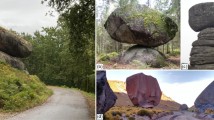Abstract
Two techniques are used to study the stress field in the Tangshan region. First, the mean directions of principal stress axes in three subregions of the Tangshan aftershock region are determined from 29 focal mechanism solutions. In doing so a slip-fitting technique is applied which determines the mean stress tensor by minimizing the angle between the observed slip direction on every fault plane and the calculated shear stress resolved onto the fault planes. Each of the two nodal planes of the focal mechanism solutions are alternately considered as a possible fault plane. Second, by making a grid search over all possible orientations of stress axes, the meanP,B andT axes in the Tangshan region, both before and after the Tangshan mainshock, are found on the basis of firstP-wave polarity readings from a number of small earthquakes. The results indicate that there is a possible azimuthal change of the principal stress axes in the focal region due to the occurrence of the mainshock.
Similar content being viewed by others
References
Angiller, J. (1979),Determination of mean principal direction of stresses for a given fault population. Tectonophysics56, T17-T26.
Angillier, J. (1982),Inversion of field data in fault tectonics to obtain the regional stress. I.Single phase fault populations: A new method of computing the stress tensor, Geophysics. J. R. astr. Soc.,69(3), 607–622.
Ellsworth, W. L. andXu Zhonghuai (1980),Determination of the stress tensor from focal mechanism data EOS61, 117.
Ellsworth, W. L. (1981),A general theory for determining the state of stress in the Earth from fault slip measurements, Terra Cognita2(2), 170–171.
Etchecopar, A., Vasseur, G. andDaignieres, M. (1981),An inverse problem in microtectonics for the determination of stress tensor from fault striation analysis, J. Struct. Geol.3(1), 51–55.
Hebei Provincial Seismological Bureau. The Catalog of Tangshan Earthquakes, (Seismological Press, Beijing, 1980)
Li Qin-zu, Diao Guiling andDai Yinghua (1983),The stress release and adjustment process during Tangshan earthquake sequence, Acta Geophysica Sinica26(3), 224–236.
Smirnov, F. E. (1956),Courses of advanced mathematics Vol. 3, 1 (Originally in Russian, translated into Chinese).
Wang Suyun andXu Zhonghuai (1985),Seismo-tectonic stress field in east China, Acta Seismologica Sinica7(1), 17–32.
Xu Zhonghuai, Yan Ming, andZhao Zhonghe (1983),Evaluation of the direction of tectonic stress North China from recorded data of a large number of small earthquakes, Acta Seismologica Sinica5(3), 268–279.
Yamakawa, N. (1971),Stress fields in focal regions, J. Phys. Earth19, 347–353.
Zoback, M. L., andZoback, M. (1980),State of stress in the conterminous United States, J. Geophys. Res.85(B11), 6113–6156.
The 1976 Tangshan Earthquake. Edited by a special editorial group under the Chinese State Seismological Bureau (Seismological Press, Beijing, 1982), pp. 459 (in Chinese).
Author information
Authors and Affiliations
Rights and permissions
About this article
Cite this article
Xu, Z., Wang, S. A possible change in stress field orientation due to the 1976 Tangshan earthquake. PAGEOPH 124, 941–955 (1986). https://doi.org/10.1007/BF00879620
Received:
Accepted:
Issue Date:
DOI: https://doi.org/10.1007/BF00879620




